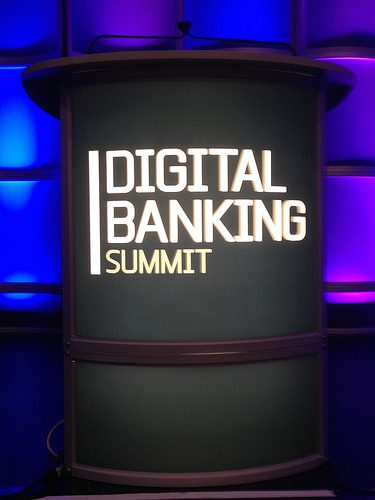We hope you are enjoying our Behind the Scenes series.
Every Finovate conference brings a new cohort of startups and entrepreneurs into the Finovate family. Behind the Scenes helps you get to know these innovators, and the new products and services they are providing, that much better.
Catch up with previous installments of our Behind the Scenes series below.
- BodeTree, Roostify, and Smart Asset
- Pellucid Analytics, Red Giant, and Zumigo
- ChiaraMail, Dealstruck, and LendingRobot
- Market Prophit, Nearex, and Sureify
- Tactile Finance, Visible Equity, and Vorstack
- Rippleshot, TextPower, and WePay
- CUneXus, ID.me, and Venovate
In our latest installment, we introduce you to mobile banking technology innovator,
Digital Insight; mobile wallet specialist
Loop; and Swedish PFM developer,
Qapital.
What they do
Digital Insight leverages mobile and online channels to help banks and financial institutions intensify customer engagement, and diversify revenues through location-based cross-selling.
The company’s Promotion Suite for mobile, demoed at FinovateSpring, gives banks the ability to provide contextual, highly-relevant products and services to their customers when their customers are most likely to want and use them.
The solution uses geo-location technology and the ubiquity of mobile phones to give consumers what they want when and how they want it. “Imagine if you were able to be there for your customers at their time of need, exactly when they needed you,” said Digital Insight Director of Product Management Karishma Anand from the Finovate stage. “That’s possible.”
The Stats
- More than 11 million online banking customers
- More than 4 million mobile banking end users
- Acquired by NCR in January 2014
The experience
Helping banks become a greater part of the world of e-commerce is a major theme for FIs looking for new ways to grow revenues. And while there are many potential services banks could provide their customers, facilitating commerce and e-commerce via financing may be among the lowest hanging fruit on the proverbial tree.
Digital Insight provides the example of a consumer shopping for a new car. With a banking app that includes Digital Insight’s location-based cross-selling solution, this shopper could receive a notification alerting her to an auto loan from her bank as soon as she pulls into the parking lot of the auto dealership.
Clicking on the message opens up the notification. In the case of an auto loan, the alert could feature information about the car, the loan rates available, and even a calculator to help the customer determine the affordability of the loan.
If the customer were not interested in the message from her bank – or not interested at the moment – the app provides an easy way to either stop further notifications or to have the bank remind her later via phone, email or text.
Where the app gets especially interesting is the way it allows customers to contact their bank to move the process forward, either by email, phone, or even features such as video chat. Banks also have the ability to integrate their own loan processing technology with the app.
What’s next from Digital Insight? With the tumult of acquisitions now behind it (two in less than a year), the company is focused on product development. Promotion Suite for mobile is on track for limited availability by the end of the year, with video integration likely in 2015.
What’s important, expressed Karishma, is that the company has not slowed down as it has moved from independence, through its growth as part of Intuit, and now as a member of NCR. In fact, she sees the latest acquisition as an opportunity for the company’s technology to reach an even greater number of consumers.
“The financial sector probably doesn’t even know about the entirety of NCR,” she says. “They touch consumers in more ways than people realize.” So, too, may Digital Insight.

What they do
Loop has developed a smart mobile wallet system that can be used at virtually all POS terminals. The company’s technology does this without the merchant having to make any changes to existing POS hardware and infrastructure.
The stats
- Founded in August 2013
- Headquartered in Burlington, Massachusetts
- Raised more than $10 million in funding
The experience
In Loop CEO Will Graylin’s colorful description, Loop represents the “first mobile wallet bullet train that has existing rails that can reach the vast majority of stations today.”
Why is this important? First, speed. Mobile wallet technology has to be faster and more efficient than pulling a credit or debit card from a physical purse or wallet. Second, in order to be
adopted quickly and widely, there needs to be as little adjustment as possible – for both consumer and merchant.
Having seen Loop in action during a briefing months ago, I can attest to the speed with which a common transaction – purchasing a couple of lattes at a local coffee shop- was completed. I was with Damien Balsan, VP for Business Development and Strategy, who was demoing the technology, and he already had the mobile app loaded with a set of credit and debit cards. Basically any card with a mag stripe that you’d carry in your wallet, he had loaded into his Loop app.
If anything, there was a modest “Wow” factor on the part of the barista (and a few other employees who happened to pass by). And while that was truly a positive verdict in many ways, it might not have been appreciated had there been a queue behind us.
Being able to rely on existing hardware is a huge deal for potential adoption. On the merchant side, there is literally no change. With the exception of the kind of card readers typical at gas station pumps, readers that require the actual insertion of the physical card, more than 90% of the existing POS terminals that take credit and debit cards will have no problem taking payments via Loop.
On the consumer side, in addition to the mobile app, users can use a fob (below) to swipe card information into the Loop app. The interesting thing about the fob is that it not only stores the users’ card information, but also can be used to make mobile payments independent of the mobile phone in venues like bars and restaurants.
Users can also opt for a carrying charge case for their smartphone that will serve the same function as the fob when it comes to both entering card information into the app as well as actually making mobile payments at the POS.
The technology behind Loop is fascinating in and of itself. While the rest of the world wrangles over NFC, Loop has leveraged its expertise in magnetic secure transmission technology to produce a way to convince the mag stripe readers of POS systems that they are interacting with the mag stripe of a credit or debit card. The magnetic field created by a simple loop of wire embedded in the Loop fob or charge case is both short-term and short-range (users hold their phone approximately four inches from the card reader), lending to both the speed and security of the transaction.
Loop believes that its technology solves a number of mobile wallet problems at the same time, from ease of use, to the centrality of the smartphone, to the lack of any hardware changes on the merchant end. Will put the challenge this way:
“In order for 1% of lead users to be happy enough to change their habits, and not rely on plastic cards or their leather wallet, they must have a critical mass of merchants that accept that payment form, which we believe is 80%. Until you get to that critical mass, you can’t even get lead users.”
Going forward the company already has its Loop fob on the market, and the charge case is expected to be available soon. Will says that Loop is working with some of the largest mobile device manufacturers to potentially embed the loop technology into mobile devices. This would be a move that would in some ways change the way Loop has introduced its business to the public. But the upside could be getting the technology in the hands of far more consumers far faster, and its hard to see an argument against that.
What they do
Is what keeps many people from spending smarter and saving better simply a matter of how boring and unfulfilling the budgeting process is? Qapital’s insight is to combine the less pleasant aspects of spending analysis (none dare call it budgeting) with the far more pleasant goal-setting and planning.
By connecting the two, Qapital’s technology helps consumers not only make better choices when it comes to spending, but turns those times when consumers do spend into opportunities to help move them closer to their goals.
The stats
- Founded in September 2012
- Headquartered in Stockholm, Sweden
- Technology live in Swedish market; closed beta in U.S.
- Estimated product launch in November 2014
The experience
Qapital is designed to make it easy for consumers to answer three of the most common personal finance questions: How am I spending my money? How much money can I spend? How can I manage my finances to help me achieve goals?
Answering the first question was the easy part, in many ways. But as the team continued to develop and test the technology, it became clear that the other two questions were just as important when it comes to helping people effectively managing personal finances in the post-budget era. The company’s testing process (more on this below) encouraged them innovate further, adding and fine-tuning both the savings and goal-managing features of the app.
The result is an app that not only puts the key, must-have, PFM elements – budgeting, account aggregation and so on – alongside more unique features like Smart Saving and Safe Balance. But also the app connects all of these features on a behavioral level (“connecting virtues and vices” as they put it), making saving that much easier for people who have trouble with the admittedly abstract problem of trading off “the now” for “the later.”
Qapital’s Smart Saving approach allows consumers to see their spending in the context of larger goals, like
saving for a vacation in a year’s time. But more than that, the technology actually helps consumers make progress both toward limiting potentially budget-busting (or, at least, goal-diminishing) spending decisions.
And as Qapital CEO noted from the stage at FinovateSpring during his company’s demo, those using the app can move real money from real connected, FDIC-insured accounts. This means, for example, that every time a purchase of one type is made (such as in the example of Starbucks above), a specified amount is transferred to the pre-arranged goal account (the trip to Africa in the above example).
Users can see the goal section of the app, which indicates the deadline by which the goal is to be reached, the estimated duration, and even a motivational photograph to help the user stay on the path to smarter and more fulfilling spending and saving.
Qapital calls this “rule-based savings”. And depending on the user’s disposition, the rules can be set up as rewards (“save a $1 in my vacation account every time I go to the gym”) or punishments (“set aside $5 in my new motorcycle account every time I eat a cupcake”) or both.
Qapital’s app also includes a “safe to spend” feature called “Safe Balance”, something that is a must-have for any PFM today. In fact, it is technologies like these that are helping people move away from the old-fashioned notion of budgeting toward a real-time understanding (and projection) of cash flow.
As I mentioned, the beta process has been critical to the technology’s development according to the Qapital team with whom I spoke at FinovateSpring in San Jose. A year’s worth of testing showed that the savings component was critical, turning the app from a run-of-the-mill expense tracking PFM tool to a higher-frequency use resource that actually helps users accomplish real financial goals.
Partnerships with companies like Social Money and Plaid are helping Qapital brings its PFM technology to the U.S. – likely before the end of the year. Qapital is live in its home country of Sweden since December 2013, and is currently in closed beta in the United States.
 Top Image Systems launches eFLOW Signature Verification.
Top Image Systems launches eFLOW Signature Verification.































